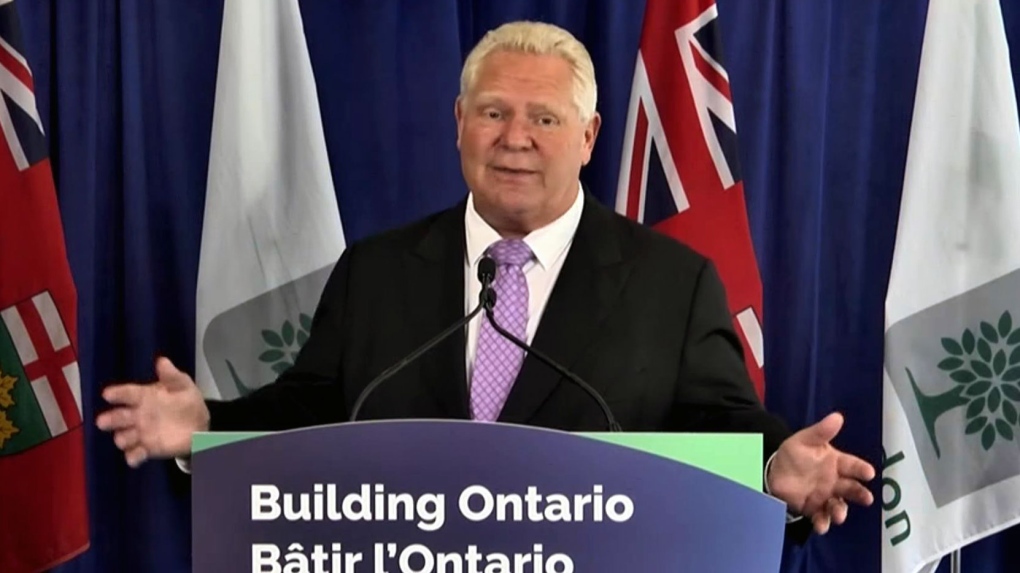What's preventing more residential growth in downtown London?
London’s building boom has pushed the downtown to the limit of its sewage capacity.
On Monday, Ontario Premier Doug Ford was in London to announce an investment of almost $24 million to support more residential development in the downtown core.
The provincial contribution will offset about three-quarters of the cost to install a larger pipe to carry sewage from Downtown London to the Greenway Wastewater Treatment Plant.
City hall is picking up the remaining costs.
“How can you build more homes if you don’t have proper water, wastewater, and sewer systems to build the homes?” asked Ford. “So we’ve stepped up in a big way.”
Eliminating the sewage bottleneck will unlock capacity to build an additional 17,576 residential units in the downtown.
“We are fully committed to the province's goals of building more housing in this community, and that is why the infrastructure in the City of London is so incredibly important,” said Mayor Josh Morgan.
The current pipe that runs beneath the forks of the Thames was installed in the 1930s.
 Ontario Premier Doug Ford speaks in London, Ont. on Aug. 26, 2024. (CTV News file image)
Ontario Premier Doug Ford speaks in London, Ont. on Aug. 26, 2024. (CTV News file image)
Installation of the new pipe will avoid disturbing the sensitive ecosystem by tunnelling beneath the river.
“We’ll be micro-tunneling the new sewer underneath the river,” explained Ashley Rammeloo, director of Water, Wastewater, and Stormwater.
Micro-tunneling is a state-of-the-art construction technique that gradually digs a tunnel while simultaneously forming the sewer to prevent a collapse.
The technique has been used in a handful of other projects in London where digging a trench is not feasible.
The new pipe will be installed in 2025, permitting a number of new residential high-rise projects in Downtown London to break ground.
CTVNews.ca Top Stories

From essential goods to common stocking stuffers, Trudeau offering Canadians temporary tax relief
Canadians will soon receive a temporary tax break on several items, along with a one-time $250 rebate, Prime Minister Justin Trudeau announced Thursday.
She thought her children just had a cough or fever. A mother shares sons' experience with walking pneumonia
A mother shares with CTVNews.ca her family's health scare as medical experts say cases of the disease and other respiratory illnesses have surged, filling up emergency departments nationwide.
Trump chooses Pam Bondi for attorney general pick after Gaetz withdraws
U.S. president-elect Donald Trump on Thursday named Pam Bondi, the former attorney general of Florida, to be U.S. attorney general just hours after his other choice, Matt Gaetz, withdrew his name from consideration.
A one-of-a-kind Royal Canadian Mint coin sells for more than $1.5M
A rare one-of-a-kind pure gold coin from the Royal Canadian Mint has sold for more than $1.5 million. The 99.99 per cent pure gold coin, named 'The Dance Screen (The Scream Too),' weighs a whopping 10 kilograms and surpassed the previous record for a coin offered at an auction in Canada.
Putin says Russia attacked Ukraine with a new missile that he claims the West can't stop
Russian President Vladimir Putin announced Thursday that Moscow has tested a new intermediate-range missile in a strike on Ukraine, and he warned that it could use the weapon against countries that have allowed Kyiv to use their missiles to strike Russia.
Here's a list of items that will be GST/HST-free over the holidays
Canadians won't have to pay GST on a selection of items this holiday season, the prime minister vowed on Thursday.
Video shows octopus 'hanging on for dear life' during bomb cyclone off B.C. coast
Humans weren’t the only ones who struggled through the bomb cyclone that formed off the B.C. coast this week, bringing intense winds and choppy seas.
Taylor Swift's motorcade spotted along Toronto's Gardiner Expressway
Taylor Swift is officially back in Toronto for round two. The popstar princess's motorcade was seen driving along the Gardiner Expressway on Thursday afternoon, making its way to the downtown core ahead of night four of ‘The Eras Tour’ at the Rogers Centre.
Service Canada holding back 85K passports amid Canada Post mail strike
Approximately 85,000 new passports are being held back by Service Canada, which stopped mailing them out a week before the nationwide Canada Post strike.
































